Growing onions in greenhouses: description of technology and rules
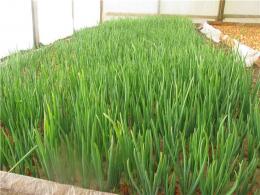
Onions take first place among green forcing plants, being the most valuable product in winter. It is consumed both fresh, fried, stewed and boiled. There are several different technology options for growing onions in a greenhouse.
Content:
Preparatory work
For year-round cultivation Vitamin greens, first of all, you need to choose the right varieties and hybrids. Strict adherence to agricultural technology and soil fertility are of no small importance. Planting onions in greenhouses begins in October in wooden or plastic boxes that can be stacked on top of each other. After a two-week period, they are taken out and installed in greenhouses, where further forcing is carried out. Agricultural economics when growing onions is based on the correct and timely preparation of material for planting.
In terms of economy, it is more advisable to use southern varieties of onions, the size of which does not exceed the average. They have a short dormant period, which allows for quick harvests.
To further shorten the dormant period and significantly increase the yield, planting material should be soaked in warm water for at least 12 hours. Having taken out the bulbs, dry them, after which the necks are carefully cut off. This will speed up the greening process.Another acceleration option is also possible, in which the onion to be planted is poured into heaps in a warm room, watered with water, the temperature of which should not be higher than 30 degrees.
After this, the bulbs are covered with burlap and kept under it for at least 4 days.
The speed of feather forcing largely depends on the time of planting and on average ranges from 13 to 22 days. The grade and quality of the material are also of great importance. Experience shows that, subject to optimal technologies for growing onions in a greenhouse, greenery appears already on the 4th day, giving a subsequent increase of up to 3 cm per day. Shallots, popularly known as “kushchevka,” offer good prospects for forcing. True, due to the length of the dormant period, it is recommended to plant it no earlier than the second half of winter.
Planting technology and recommended types
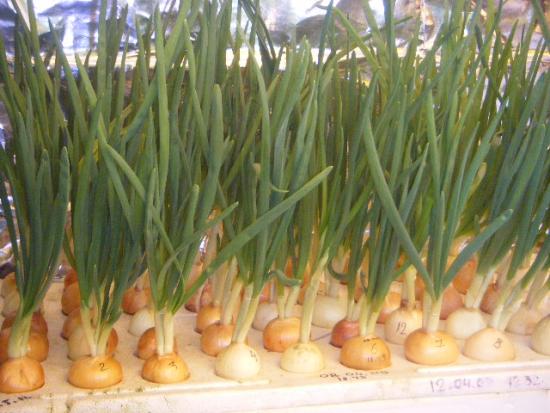
Planting onions it is necessary to plant in the ground using a bridge method, pressing the bulbs tightly against each other. This allows you to significantly save space, driving out beautiful, juicy greens. With this method, about 10-12 kg of planting material will be required per square meter. The air temperature should be within 22 degrees. Water the plantings no more than once every 10 days. From two weeks of age, there should be constant lighting in the greenhouse, which will not allow the greens to turn yellow and become less juicy.
When choosing varieties for planting, pay attention to the most recommended for greenhouse cultivation, the species that have a minimum dormant period. These include:
- Multi-tiered onion
- Slime Bow
- Onion
- Shallotte
- Bulb onions
A short description of each type will help you make your choice.
- Multi-tiered onions are considered the most profitable and unpretentious.It can be grown quite well in low light and relatively low temperatures. In this case, the seed material is underground bulbs (false) and bulblets, 1 kg of which can produce at least 2 kg of full-fledged high-quality greens within 25-30 days.
- Slime onion is a very early ripening and frost-resistant species that has become widespread in recent years. Having wide leaves with rounded ends, a delicate taste and a light garlic aroma, it looks a little like an onion. This high-yielding species can grow all year round, so it can be planted in a greenhouse at any time. For this, bulbs with pieces of rhizome are used. The plant is very unpretentious and does not need high temperatures.
- In comparison with onions, spring onions have more even greens and a fairly low cost. Therefore, forcing greenery out of it seems more profitable.
- Bulb onions It is much more profitable to grow in greenhouses starting in March. It is most convenient to plant it in small boxes measuring 40*60 cm. This is done to quickly move the plantings to another location if the need arises. Only in this case can you get a good profit from it.
Using the correct technology for growing onions in a greenhouse, you can grow an excellent harvest from each listed species.
Growing onion greens correctly
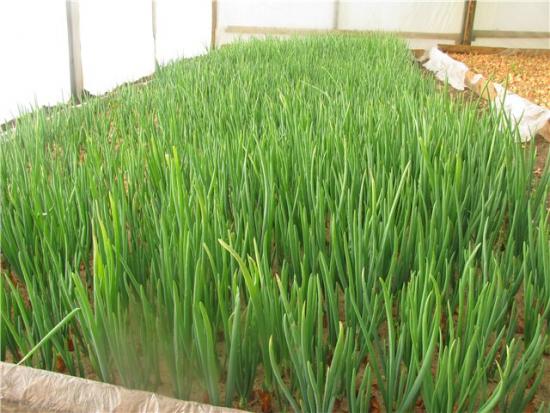
Preparing the soil for forcing is of great importance. It should be enriched with easily digestible nutrients. To do this, the soil must be mixed with peat and humus, superphosphate 30 g/area and sodium chloride 15 g/area added, and well moistened.
Leek on a feather
Leeks, which have an extraordinary taste and delicate aroma, are grown using seeds that are soaked before planting for 5-6 hours in lukewarm water. It is advisable to disinfect the water by adding “Epin” or “Zircon” to it, which will simultaneously stimulate plant growth. To obtain seedlings, seeds must be planted in separate containers. The amount of soil in them should not exceed 2/3 of the volume.
The seeds are sprinkled with earth, after which the containers are covered with glass or film and transferred to a warmer place. Watering is carried out no more than once every 3 days, and the film is not removed until completely appearance of greenery.
Before transplanting the onions into the greenhouse, the soil is fertilized with humus and ash. When planting, the distance between the bulbs should be at least 10 cm. To obtain juicy, non-bitter greens, leeks must be watered at least once a week and periodically weeded.
Obtaining a tall white leg is achieved using certain tricks. Before planting the bulb, a deep groove is dug in the ground, to the bottom of which the planting material is sunk. As it grows, the soil is constantly replenished, thanks to which the leek “climbs” upward.
Chives on a feather
The technology for growing onions in a greenhouse is not particularly difficult. Reproduction of the plant occurs with the help of a large number of thickenings of the rhizome, growing throughout the growing season. In the last days of autumn, chives are dug out of the ground and left to “rest” for 21 days, after which they begin to plant them in greenhouses.
To awaken a plant from sleep, it must be planted in loose soil, watered with warm water.Until the greens germinate, it is necessary to maintain the temperature within 22 degrees; when a feather appears, it is reduced to 16 degrees.
To form tasty and beautiful feathers, chives need sufficient lighting. If there is a lack of it, the plant will be pale and weak. Onions need regular, not very abundant watering; high humidity can cause rotting. The main feather forcing lasts from 3 to 6 weeks. The finished crop is cut off, leaving the bulbs intact. You can get another good portion of greens from them.
Onion feather
For growing greens They use mainly onion sets or onion heads, the diameter of which must be at least 2 cm. The number of harvests depends on the size of the head; the larger it is, the better. Large bulbs have a high supply of plates that form the feather. Immediately after planting, water the onions with slightly warm water. For the full development of the root system, it is necessary to maintain the temperature within 12 degrees for several days. After which, the temperature is raised to 20 degrees, remaining in this mode until the crop is completely forced out.
By following the technology for growing onions in a greenhouse, the harvest can be obtained as early as 25 days. And, besides this, from November to March you can get about 4 fees, building a good business on this. To obtain regular harvests, onions can be planted every 10-15 days, which will create a non-stop conveyor.
Using a greenhouse allows you to obtain tasty and healthy products despite the weather outside. Maintaining optimal air and soil temperatures, timely watering and fertilizing will provide an excellent reward.
Video about the correct placement of a bow on a feather:
Interesting information about the vegetable garden

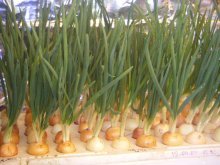
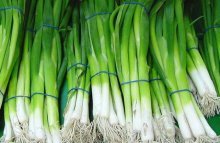
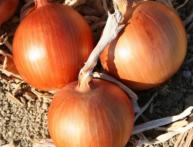
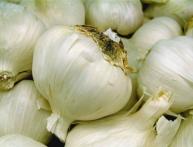
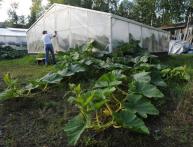
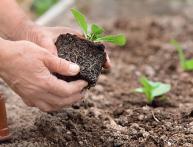
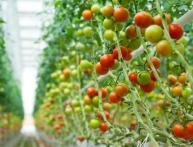



Comments
Has anyone tried growing under LED lamps?